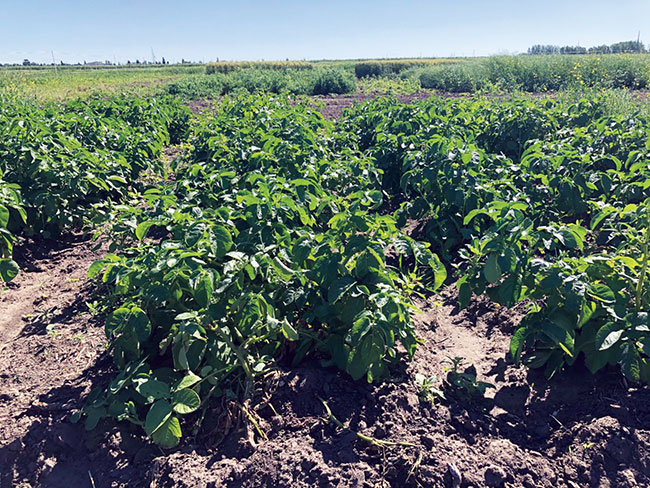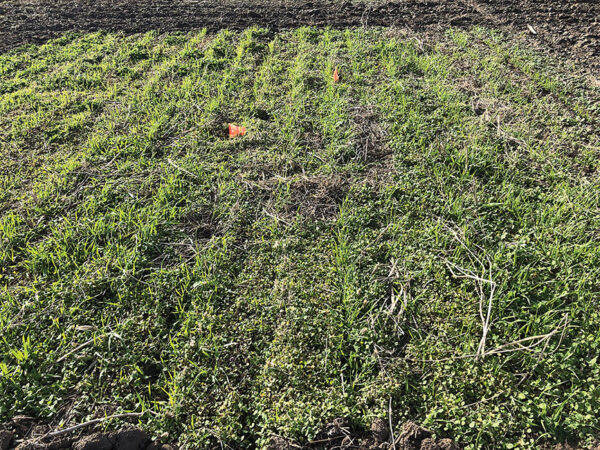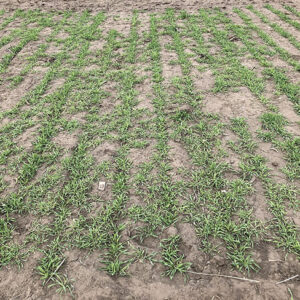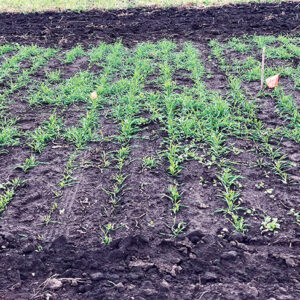
Features
Crop Protection
Cover cropping strategies for the Prairies
Cover crops and nitrogen cycling in a Saskatchewan potato rotation.
September 1, 2023 By Carolyn King
 Potato has high nitrogen needs and typically receives high nitrogen fertilizer rates, so cover crops that improve soil nitrogen cycling could be very helpful.
Photo courtesy of Olivia Otchere/University of Saskatchewan.
Potato has high nitrogen needs and typically receives high nitrogen fertilizer rates, so cover crops that improve soil nitrogen cycling could be very helpful.
Photo courtesy of Olivia Otchere/University of Saskatchewan. “Cover cropping has been recognized as a promising management practice that can provide several agronomic, environmental and economic benefits. However, on the Prairies, the short growing season and the dry conditions make it challenging to integrate cover crops into cropping systems,” says Olivia Otchere, a research technician with Kate Congreves’ research group at the University of Saskatchewan.
As an MSc student, Otchere carried out a recently completed study that looked at the viability of using cover crops in Saskatchewan and assessed one of the key potential benefits of cover crops – the improvement of soil nitrogen cycling.
Congreves led this study, which was conducted in collaboration with Yvonne Lawley at the University of Manitoba and funded by the Western Grains Research Foundation.
Nitrogen and cover crops
Otchere notes that, depending on the growing conditions, only about half of the nitrogen fertilizer applied to a crop is typically used by that crop. The unused nitrogen is at risk of losses through leaching and gaseous emissions. Such losses are harmful to the environment and a waste of valuable fertilizer inputs.
Cover crops can help with this problem. Otchere explains, “Research elsewhere in Canada shows that using crop rotations that include cover crops can improve crop nitrogen-use efficiency. Cover crops can help tie up nitrogen when it would otherwise be lost, and then give it back to the soil in time for cash crop production.”
The study team wanted to know if this nitrogen cycling benefit would also occur under Saskatchewan growing conditions. So, they conducted a field experiment at Saskatoon from 2018 to 2021 using underseeded and shoulder-season cover crops.
They looked at a long rotation of wheat-canola-potato-pea without cover crops, and this same rotation with cover crops. The cover crop sequence was: wheat (red clover)-canola (berseem clover/oat mixture)-potato (fall rye)-pea (tillage radish/mustard mixture). The red clover was underseeded to wheat, while all the other cover crops were planted after harvesting the cash crop. In the following spring, the cover crops were terminated with herbicides before the next cash crop was seeded.
The experiment also included a wheat–canola rotation as an example of a short rotation, and alfalfa as an example of a perennial crop system.
The plots were fertilized in the spring based on the soil test recommendations for each main crop. The fertilizer rates were based on conventional practice (so they were not adjusted based on the cover crops’ nutrient needs in the rotation with cover crops).
Nitrogen (N) is available to plants as soil inorganic N, either in the form of ammonium (NH4) or nitrate (NO3), which can be lost to the environment. In this study, the team monitored plant-available N in several ways including: pre-plant soil nitrate; soil inorganic N supply rate; and potentially mineralizable N, which is the fraction of soil N that is fairly easy for microbes to break down and make available to plants over the growing season.
The team also collected data on the cover crops, such as ground cover and above-ground biomass, and data on the cash crops, such as crop yield and above-ground biomass, and calculated crop N-use efficiencies.

In this study’s four-year rotation, a berseem clover/oat mix was seeded as the shoulder-season cover crop between canola and potato.
Potatoes and cover crops
Although potato is not a major crop in Saskatchewan, it is a good example of a crop with high N needs that typically receives high N fertilizer rates. Also, the tillage, hilling and harvesting operations in potato production systems increase the risk of soil erosion and the loss of soil organic matter and nutrients. Therefore, cover crops can be valuable in potato production systems for improving both soil health and nitrogen cycling.
Otchere explains why the team chose a berseem clover/oat mixture as the cover crop between canola and potato. “When you have a mixture of legumes and grasses, the legumes can fix nitrogen while the grasses can scavenge for excess nitrogen from the soil. The mixture of berseem clover and oat was chosen to effectively manage nitrogen for two of the main crops in the rotation which are both high-nitrogen users, canola and potato. The idea was that any residual nitrogen losses would be minimized by the oat due to its nitrogen scavenging abilities, while the berseem clover fixes nitrogen. So, at the end of the day, their combined effect would ensure a lower carbon to nitrogen ratio and a faster breakdown of tissues which might improve the nitrogen supply in time for the potato crop.”
Fall rye as the cover crop between potato and pea has several potential benefits, notes Otchere. “Fall rye develops rapidly and produces considerable amounts of biomass. Pea, as a legume, can increase nitrogen supplies by N fixation. By returning the rye residues with a higher carbon to nitrogen ratio to the soil, nitrogen might be immobilized temporarily, which would reduce the potential for nitrogen losses after pea harvest.”
Fall rye also offers other possible advantages; for instance, it is winter-hardy and competitive with weeds, and it is good at scavenging N, building soil organic matter and preventing soil erosion.
Result highlights
Otchere points to some of the interesting findings from this study.
First of all, the results suggested that cover crops could be viable in the Prairie region since the cover crop species in this trial were able to become established and achieve some growth. However, their above-ground biomass amounts were far lower than the typically desired amounts for cover crops, so there is definitely room for improvement.
The study’s winter-hardy species – red clover and fall rye – produced more biomass than the non-hardy species – berseem clover/oat and tillage radish/mustard.
Red clover and fall rye were also good performers in terms of their N content. Red clover had the highest N content, but fall rye was a close second due to its ability to scavenge and store N in its large amount of biomass.
The results also showed that the cover crops in this study could influence soil N cycling, but only during the fall, when they reduced postseason soil N losses through cover crop N uptake. Furthermore, the long rotations with and without cover crops were not significantly different from each other in terms of their crop yields, crop N-use efficiencies and in-season N dynamics.
It is possible that the spring N fertilizer applications may have masked any cover crop effect on the soil inorganic N supply in the summer. Another possibility is that the relatively low amounts of cover crop biomass may have limited the cover crops’ influence on N cycling.
“Interestingly, when cover crops were included in the long rotation, the cropping system tended to behave more like a perennial system in terms of the regulation of nitrogen,” says Otchere. So, over a longer time frame than the three years of this study, the cover cropped rotation could potentially have bigger benefits for N cycling.
- Fall rye after overwintering: fall rye was one of the better performing cover crops in this Saskatoon study, but all the cover crop species produced relatively low amounts of above-ground biomass.
- Fall rye in the fall, planted after the potato harvest.
Take-home messages, future research
“On the Prairies, especially in potato production, cover cropping might be a useful tool to help manage soil nitrogen, but we acknowledge that more work still needs to be done to figure out how we can optimize the economic, environmental and agronomic benefits of cover cropping,” says Otchere.
“I believe that for cover crops to be successful on the Prairies, several factors need to be considered like species selection, methods of integration, management, weather conditions and fertilizer management.”
For example, she would like to see longer-term research to identify and develop fast-growing, winter-hardy cover crop species and varieties that perform well under Prairie growing conditions and to find ways to add cover crops into Prairie cropping systems earlier in the growing season.
Otchere concludes, “Cover cropping has been promoted as being a sustainable and suitable management practice that can influence nitrogen availability as well as provide many soil health benefits. Today, cover cropping is not a really widespread practice on the Prairies, but a recent survey found farmers are adopting cover crops even in the driest regions of Alberta, Saskatchewan and Manitoba. As researchers, we need to catch up so we can better support our farmers.”
Print this page

